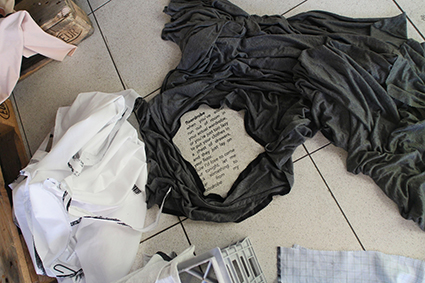The zero waste cut
Varia Karipoff: INTGRS, Australia Melbourne Fashion Festival

Floordrobe, Cluny McCullagh
image courtesy the artist
Floordrobe, Cluny McCullagh
Intgrs/integer/whole. Integrity. Disclaimer: it is my opinion that the fashion industry doesn’t seem to have a lot of stock to trade in integrity. I am not, however, conflicted by the fact that I love clothing: design, cut, texture, fabrication.
Walking through Southbank in Melbourne, which is a cluster of towering, faceless residential blocks set on fast-moving arterial roads, I reach Testing Grounds, the venue for INTGRS. It is a little patch of abandoned industrial dirt abutting the glittering spire of the Arts Centre that has been converted into a quiet experimental art space. The plot of land is filled with wooden crates fashioned into outdoor furniture while shipping containers reveal project spaces. Inside one of these is the artist, Cluny McCullagh. She is articulate and energetic, having recently returned from Antwerp where she was cataloging historical clothing at the ModeMuseum.
INTGRS, the major project of McCullagh’s MA, invites participants to pick up garments from the Floordrobe (“no hangers, no hierarchies”) and to sculpt the pieces to the body. There is a notable absence of mirrors in this shop floor-cum-project space. All the pieces are zero-waste, meaning that any cutting has not resulted in material being discarded. Instead McCullagh’s proposed toolkit consists of cutting templates, a curved shape which resembles bra underwire but thicker, and an oblong not unlike a half-sized ruler which provide both decorative functions—tassels and slits, to functional cuts—arm holes, leg holes. The pieces themselves, designed in collaboration with Dylan McDonough, are based on actual patterns without the negative space and waste. The fabrication and length of these fringed and perforated oblongs determine initial perceptions of wearability but are not limited to traditional notions of dress. The pieces seek to create possibilities and are not defined by size. A short film we view later—FLOORDROBE: redressed (Kelly Lawn, filmed in collaboration with Yvette Turnbull)—asks of a tuxedo fabric ensemble, “Is it a tuxedo or a wedding dress?”
After turning a navy tunic-type garment in my hands for a while, I decide to put my head through a large slit, which has been finished with seams. Without a mirror, I look to those in the room to gauge my success but there don’t seem to be any rules; as long as it feels right. A woman who has arrived at the same time as me throws herself into the process with real gusto, layering items unselfconsciously. Without mirrors and defined sizes, there is a playfulness to this experiment; we get a bit braver too. In pushing for the democratising of fashion and wrenching it out of the realm of desire, McCullagh has managed to retain the pleasure of clothing—powder blue silk glides over me like water and I imagine a magic evening gown. The act of dressing with INTGRS becomes a communal event, where participants are co-creators of new styles.
Leaving the clothes for a minute, I venture to look over at the supporting work for INTGRS, the cutting templates that the artist has created and a beautifully designed book that further provides ideas and inspiration to bring integrity into fashion. The flexibility of McCullagh’s BA in Design (Fashion) at RMIT University allowed her to closely examine fashion in the context of design research and innovation. She has a healthy irreverence for fashion, dressed today in a T-shirt with a print photo of breasts, which she wore to fashion shows, making sure to sit close to the runway in the hope that she would be photographed during the “Free the Nipple” campaign. Her interests go beyond fashion to design, particularly social innovation and non-intentional design—how we make do at a pinch such as when, for instance, we use a key to open letters on the way into the house, she explains.
Though impressed with the age and condition of the museum pieces in Antwerp, McCullagh saw first-hand how fashion is cyclical, seemingly always in a state of flux but essentially unchanging. These garments embody status, desire, gender and size. Since the Renaissance, when loose robes gave way to tailored garments, cutting has been at the fore of clothing production, which brought both waste and waist-lines into the equation. Design (such as cities, housing—Southbank being a fine example) comes weighted down with the past, with little thought to resetting the model. With INTGRS McCullagh gives a small glimpse into the possibilities of where rethinking fashion can take us. Now if I can just get the confidence to wear this tunic beyond the door of the shipping container.
Australia Melbourne Fashion Festival: Cluny McCullagh, INTGRS, Testing Grounds, Melbourne, 28 Feb-4 March
RealTime issue #126 April-May 2015 pg. 47






